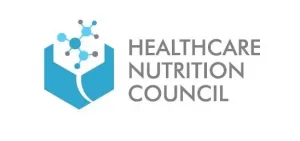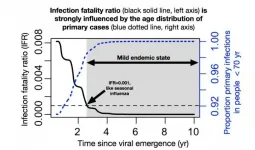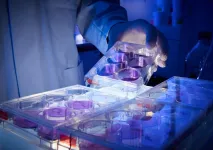(Press-News.org) ATLANTA - JANUARY 12, 2021 - Overall cancer death rates in the United States dropped continuously from 1991 through 2018 for a total decrease of 31%, including a 2.4% decline from 2017 to 2018. The news comes from the American Cancer Society's annual Cancer Statistics, 2021 article, appearing in CA: A Cancer Journal for Clinicians, and its consumer version, Cancer Facts & Figures 2021. This year marks the American Cancer Society's 70th anniversary of reporting this data to inform the nation's fight against cancer.
The report estimates that in the U.S. in 2021, almost 1.9 million (1,898,160) new cancer cases will be diagnosed and 608,570 Americans will die from cancer. These projections are based on currently available incidence and mortality data through 2017 and 2018, respectively, and thus do not account for the impact of the COVID-19 pandemic on cancer diagnoses or deaths.
"The impact of COVID-19 on cancer diagnoses and outcomes at the population level will be unknown for several years because of the time necessary for data collection, compilation, quality control, and dissemination," said Rebecca Siegel, MPH, lead author of the report. "We anticipate that disruptions in access to cancer care in 2020 will lead to downstream increases in advanced stage diagnoses that may impede progress in reducing cancer mortality rates in the years to come."
Progress in reducing mortality has slowed for other leading causes of death in the U.S., but accelerated for cancer, which is the second-leading cause. An estimated 3.2 million cancer deaths have been averted from 1991 through 2018 due to reductions in smoking, earlier detection, and improvements in treatment, which are reflected in long-term declines in mortality for the four leading cancers: lung, breast, colorectal, and prostate.
Lung cancer is the most common cause of cancer death, accounting for more deaths than breast, prostate, and colorectal cancers combined. Sluggish progress against these latter cancers in recent years contrasts with accelerating reductions in the death rate for lung cancer, from 2.4% annually during 2009 to 2013 to 5% annually during 2014 to 2018. As a result, lung cancer accounted for almost half (46%) of the overall decline in cancer mortality in the past 5 years and spurred a record single-year drop (2.4% from 2017 to 2018) for the second year in a row.
Recent rapid reductions in lung cancer mortality reflect better treatment for the most common subtype - non-small cell lung cancer (NSCLC). Two-year relative survival for NSCLC has increased from 34% for patients diagnosed during 2009 through 2010 to 42% for those diagnosed during 2015 through 2016, including absolute gains of 5% to 6% for every stage of diagnosis. Two-year survival for small cell lung cancer remained at 14% to 15% during this time period.
Cervical cancer is almost 100% preventable through screening and, in recent years, the HPV vaccine, but continues to cause thousands of deaths in the U.S. annually. Approximately 11 women per day died from cervical cancer in 2018, half of whom were in their 50s or younger. It is the second-leading cause of cancer death among women in their 20s and 30s. Although the HPV vaccine holds promise to nearly eliminate cervical cancer with complete population coverage, U.S. vaccination rates remain far below those in other high-income countries: 57% of U.S. adolescent females are up-to-date vs >80% in Australia and >90% in the U.K. Per ACS guidelines HPV vaccinations are recommended in children starting between the ages of 9 to 12, and cervical cancer testing (screening) in young women should begin at age 25.
Other highlights from Cancer Statistics 2021/Cancer Facts & Figures 2021 include:
Cancer is the leading cause of death in Hispanic, Asian American, and Alaska Native persons.
The 5-year survival rate for all cancers combined diagnosed during 2010 through 2016 was 68% in White patients versus 63% in Black patients.
For all stages combined, survival is the highest for prostate cancer (98%), melanoma of the skin (93%), and female breast cancer (90%), and lowest for cancers of the pancreas (10%), liver (20%), esophagus (20%), and lung (21%).
Survival rates are lower for Black patients than for White patients for every cancer type except pancreas.
Prostate, lung and bronchus, and colorectal cancers account for 46% of all incident cases in men, with prostate cancer alone accounting for 26% of diagnoses.
For women, breast, lung, and colorectal cancers account for 50% of all new diagnoses, with breast cancer alone accounting for 30% of female cancers.
In contrast to declining trends for lung and colorectal cancers, female breast cancer incidence rates increased by about 0.5% per year from 2008 to 2017, which is attributed at least in part to continued declines in the fertility rate and increased body weight.
Colorectal cancer overtook leukemia in 2018 as the second leading cause of cancer death in men aged 20 to 39 years, reflecting increasing trends in colorectal cancer in this age group, coinciding with declining rates for leukemia.
The Black-White disparity in overall cancer mortality among men and women combined has declined from a peak of 33% in 1993 (279 vs 211 per 100,000, respectively) to 13% in 2018 (174 vs 154).
Geographic disparities are widest for the most preventable cancers, such as lung and cervical cancers, for which incidence and mortality rates vary up to 5- and 3-fold, respectively, across states.
"While recent advances in treatment for lung cancer and several other cancers are reason to celebrate, it is concerning to see the persistent racial, socioeconomic, and geographic disparities for highly preventable cancers," said William G. Cance, M.D., chief medical and scientific officer, American Cancer Society. "There is a continued need for increased investment in equitable cancer control interventions and clinical research to create more advanced treatment options to help accelerate progress in the fight against cancer."
INFORMATION:
Article: Siegel RL, Miller KD, Fuchs H, Jemal A. Cancer Statistics, 2021. CA: CA: A Cancer Journal for Clinicians, 2021. doi: 10.3322/caac.21654.
URL upon embargo:
http://acsjournals.onlinelibrary.wiley.com/doi/10.3322/caac.21654
Note: Estimates should not be compared year-to year. They are based on computer models of cancer trends and population and may vary considerably. Cancer trends should be based on age-adjusted cancer incidence and death rates (expressed as the number of cancer deaths per 100,000 people).
Remarkably well-preserved fossils are helping scientists unravel a mystery about the origins of early animals that puzzled Charles Darwin.
Analysis of the 547 million-year-old remains has enabled researchers to trace the ancestry of some of the world's earliest animals further back than ever before.
Their study has uncovered the first known link between animals that evolved during the so-called Cambrian Explosion some 540 million-years-ago and one of their early ancestors.
Until recently, little was known about the origins of animals that evolved during the Cambrian event because of a lack of well-preserved fossil evidence.
The mysterious origins of animals that evolved at this time - when the diversity ...
Core technology includes promising bivalent single-domain antibodies simultaneously targeting two surface structures of the viral spike protein.
Lead candidates DIOS-202 and DIOS-203 are engineered for high potency and their potential to avoid the emergence of escape mutants.
DIOS-202 and DIOS-203 entered into accelerated development to initiate clinical studies later this year.
BONN, Germany, January 12, 2021 - DiosCURE SE announced a publication in Science describing its core technology of multivalent single-chain antibodies with a unique molecular mode-of-action to inactivate ...
While most people are able to eat a normal diet, many of those managing distinct nutritional requirements related to a disease or health condition rely on medical foods. Medical foods help patients meet their nutritional needs, often improving nutritional and health outcomes and quality of life. A recent publication in Current Developments in Nutrition, titled "Medical Foods: Science, Regulation, and Practical Aspects. Summary of a Workshop," shares the historical and regulatory context of medical foods and perspectives on their role in the future.
Medical foods help patients manage their nutritional needs, yet it can be very difficult for patients to have access to them. In August 2019, the Healthcare Nutrition Council (HNC), in partnership with the American Society ...
What is the endgame for SARS-CoV-2, the virus that is causing worldwide devastation? If it becomes endemic -- circulating in the general population -- and most people are exposed in childhood, SARS-CoV-2 may join the ranks of mild cold-causing coronaviruses that currently circulate in humans, according to a model developed by Emory and Penn State scientists.
The model, published January 12 in Science, draws upon studies of the four common cold coronaviruses and SARS-CoV-1. For those viruses, the term "herd immunity" is incomplete and possibly misleading, says ...
Antibodies are an important weapon in the immune system's defense against infections. They bind to the surface structures of bacteria or viruses and prevent their replication. One strategy in the fight against disease is therefore to produce effective antibodies in large quantities and inject them into the patients. The outgoing US President Donald Trump probably owes his rapid recovery to this method. However, the antibodies used to treat him have a complex structure, do not penetrate very deeply into the tissue and may cause unwanted complications. Moreover, producing antibodies is difficult and time-consuming. They are therefore probably not suitable for widespread use.
Mass production in yeast or bacteria
"We focus on another group of molecules, the nanobodies," ...
Researchers at Karolinska Institutet in Sweden have developed, in collaboration with researchers in Germany and the U.S., new small antibodies, also known as nanobodies, which prevent the SARS-CoV-2 coronavirus from entering human cells. The research study, published in Science, shows that a combined nanobody had a particularly good effect - even if the virus mutated. According to the researchers, the nanobodies have the potential to be developed into a treatment for COVID-19.
Specific proteins, spike proteins, on the surface of the SARS-CoV-2 coronavirus help the virus infect host cells. Therefore, antibodies that block the spike proteins and prevent them from binding to the cell can be a way to stop infection.
From the perspective ...
What will the SARS-CoV-2 outbreak look like ten years from now as it passes from pandemic to endemic, maintained at a constant baseline level in populations without being fueled by outside infections? Data from four endemic human coronaviruses, which circulate globally and cause only mild symptoms, may hold some answers, say Jennie Lavine and colleagues. Their analysis of the immunological and epidemiological data for these viruses helped them develop a model to predict the trajectory of SARS-CoV-2 as it becomes endemic. Most importantly, the authors say, their model incorporates distinct components of immunological protection--susceptibility to reinfection, weakening of the disease after reinfection, and transmissibility of the virus after reinfection--that each wane differently. Lavine ...
An immunization strategy tested in mice protects against infection from SARS-CoV-2, as well as from potentially emerging animal coronaviruses, researchers say. The approach could be "used as described or easily adapted" to provide defense against newly discovered zoonotic coronaviruses. In the last 20 years, three betacoronaviruses have caused devastating disease in humans. The global pandemic caused by the latest such virus, SARS-CoV-2, highlights the need to protect against other strains that could present a threat to humans, possibly through a pan-coronavirus vaccine. To support related efforts, ...
Thanks to major progress in the understanding and management of rare congenital diseases and syndromes, many patients with these rare disorders are now living longer lives. With this progress it has become apparent that many non-skeletal rare diseases have an impact on bone mass, bone quality and/or bone metabolism, with potentially severe repercussions for quality of life in adults.
The new paper 'Bone fragility in patients affected by congenital diseases non skeletal in origin', published in Orphanet Journal of Rare Diseases by the International Osteoporosis Foundation (IOF) Skeletal Rare Diseases Working Group (SRDWG), provides ...
Most people experience turbulence primarily from the experience of flying in an airplane. However, turbulence is a key feature of nature and is found everywhere, from rivers to galaxies.
Turbulent-like dynamics are difficult to capture in a still image. However, Leonardo da Vinci did everything possible to identify the underlying order of the phenomenon, which he observed in eddy currents forming randomly in water. In fact, he was fascinated by trying to understand and describe the generating principles governing such complicated dynamics. This is so much ...




